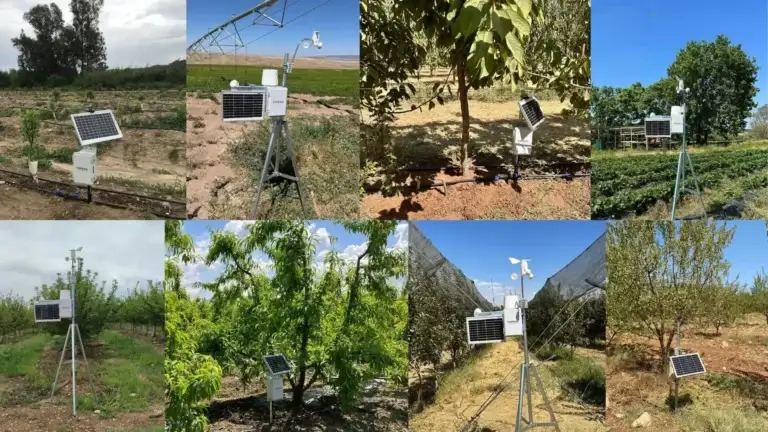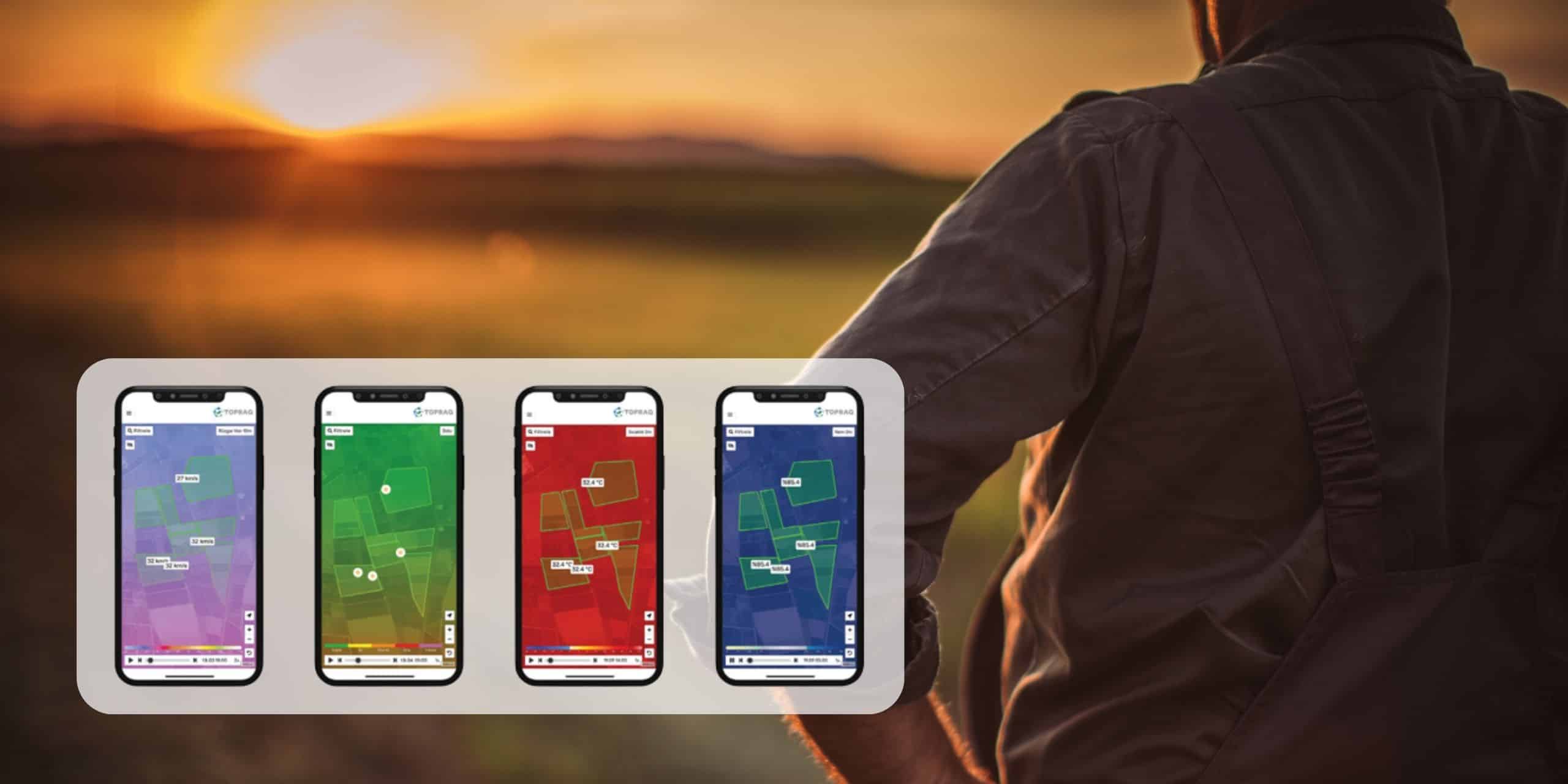Changing seasons, and extreme weather events such as heatwaves, hailstorms, storms, heavy rainfall, or drought all point to one overarching issue: Climate change. However, the impacts of climate change extend well beyond melting glaciers and rising sea levels. Those who are most severely affected are farmers whose livelihoods rely on consistent environmental conditions. In this article, we’ll explore the negative effects of climate change on agricultural production and discuss how farmers can address these unprecedented shifts by using advanced climate-smart agricultural technologies such as accurate weather forecasting and irrigation optimization.
How Climate Change Affects Agriculture
Erratic Weather Patterns
Agriculture operates as an open-air factory therefore farmers have always been at the mercy of the weather. But in recent years, climate change has introduced an entirely new level of unpredictability. Droughts, floods, and storms have become more frequent and severe, making it difficult for farmers to plan their growing seasons and take preventive measures before they cause damage to their crops.
Temperature Fluctuations
Unseasonably warm or cold weather can have disastrous effects on crops. Rising average temperatures can lead to faster evaporation rates, requiring more frequent irrigation which may not be sustainable in the long run. Given the widespread heatwave experienced worldwide this summer, it is evident that farmers had to be doubly vigilant in monitoring their crops’ irrigation requirements, carefully observing signs of stress in the plants and keeping a close watch on soil moisture levels.
Shifts in Growing Seasons
Climate change can also result in extended or shortened growing seasons, affecting the life cycle of plants and the habits of pollinators. Plants necessitate specific seasonal growing conditions, known as Growing Degree Days and Chilling Hours. To kickstart their regular growth cycle in the spring, plants require a certain duration of exposure to designated cool temperatures, referred to as Chilling Hours. Failure to meet this requirement can lead to reduced yields and various anomalies. Furthermore, plants also need a specific amount of time at designated temperatures to accomplish their fruit ripening phase, denoted as Growing Degree Days. The shifts in air temperatures contribute to noticeable variations in the timing of plant growth and harvests across seasons.
Climate Change Impact on Farmers
Reduced Yields
Unpredictable weather patterns and extreme conditions can severely reduce crop yields. As previously discussed, when plants face extreme weather conditions like high temperatures, they can experience stress. If they don’t fulfill their chilling hour requirements, it results in reduced crop production, or their harvest can be negatively impacted due to insufficient exposure to designated temperatures. Reduced yields not only affect the farmers’ income but also have broader implications for food security.
Increased Costs
In today’s world, particularly in specific regions, accessing and using water resources carries a substantial economic burden. The necessity for additional irrigation, pest control measures, and storm-resistant infrastructure results in elevated operational expenses for farmers, putting further pressure on their already narrow profit margins.
Adaptive Measures
Diversification
To adapt to the constantly changing weather conditions, farmers are diversifying their crops. This allows them to both minimize the risk of losing their crops before harvest and generate sufficient income.
Technological Solutions
Agricultural technologies are a rising trend among farmers. Agrotech products help farmers optimize their irrigations, reduce costs, and take precautions to protect their crops.
Sustainable Practices
Sustainable farming methods like no-till agriculture, crop rotation, organic farming, and agricultural technologies help improve soil resilience, making farms more robust against climatic changes.
Topraq: Assisting Farmers in Adapting to Climate Change
The Role of Technology in Climate Resilience
At Topraq our goal is to bring agriculture to a sustainable future, empowering farmers to efficiently use natural resources, and obtain high-quality and bountiful crops while reducing electricity, labor, and fertilizer costs. Recognizing the significant initial investment associated with agricultural technologies, we’ve introduced a new model into the industry, allowing farmers to integrate technology into their lives: the Subscription Model.
Rather than merely producing hardware that generates reports and leaving farmers to decipher the collected data on their own, we’ve combined our monitoring stations with digital agricultural services. We gather data from our farmers’ fields, use AI technology and algorithms to relate vast datasets and deliver our farmers relevant, user-friendly, and actionable information.

T-Weather: Agro Station
In a world where climate change has led to unavoidable extreme high temperatures, hail, gusts, and various adverse weather conditions, farmers are constantly required to remain vigilant and take precautionary measures. T-Weather, our smart meteorological station, offers a solution by enabling farmers to access real-time local weather data remotely. Equipped with an array of agricultural sensors, including Rainfall, Wind Speed & Direction, Pyranometer, and Weather, T-Weather provides farmers with a continuous data flow through easily accessible and user-friendly reports. Moreover, it provides farmers access to a 15-day local weather forecast including vital factors such as Rainfall, Temperature, Snow, Hail, Frost, Humidity, Cloud Cover, Wind Speed, and Gusts. T-Weather also serves as a smart assistant, helping farmers with crucial calculations such as Chilling Hours, Growing Degree Day, Degree Day, Dew Point, and ET0 (Evapotranspiration).
T-Irrigate: Irrigation Optimization
Why Irrigation Optimization is Crucial?
In the current era, optimizing irrigation is not a matter of choice; it’s a necessity. The accessibility to water resources and the expenses associated with irrigation pose significant challenges. Our dedicated irrigation optimization station is meticulously crafted to grant farmers comprehensive insight into their irrigation processes.
By strategically placing smart sensors beneath the soil, aligned with the irrigation infrastructure and specific crops, we collect valuable data. This data is subsequently analyzed by our AI and algorithms to generate customized, critical field water thresholds. These thresholds place a strong emphasis on water-related and root data, including factors such as the Interpolated Humidity Index, Irrigation Start Level, Irrigation Cut-Off Level, and Optimum Irrigation Area.
Thanks to a continuous flow of real-time data, farmers can monitor their irrigation activities from anywhere, at any time, eliminating the need for physical presence in the field.
Advantages of T-Irrigate: Irrigation Optimization
- Irrigation Monitoring: Field managers and farm owners gain complete visibility into their fields with up-to-the-minute data.
- Electricity Savings: Efficient irrigation practices lead to reduced electricity consumption.
- Insights: Detailed information about the conditions beneath the ground, helping optimize irrigation strategies.
- Comprehensive Irrigation Audits: Efficient assessment and management of irrigation processes along the entire irrigation line.
- Precise Rainfall Irrigation Data: Access to irrigation information measured in millimeters via rainfall data.
- Tonnage Data from Ultrasonic Flowmeter: Accurate measurement of water use through ultrasonic flowmeter technology.
- Error Minimization: Reduction in employee errors through automated and data-driven irrigation processes.
- Input Optimization: Optimized resource allocation, minimizing waste, and enhancing overall efficiency.
- Resource Conservation: Prevention of wastage of valuable water and other resources like fertilizers and labor.
- Agricultural Sustainability: Promotes sustainable farming practices, ensuring long-term environmental and economic viability.
Among the many weather-related threats, frost stands out as one of the most menacing, causing severe damage to crops and reducing product marketability. To help farmers proactively combat frost, we have developed the Frost Warning feature. With this capability, farmers can set low-temperature alarms, and our system, the Topraq Smart Assistant, will promptly alert them when temperatures drop below the specified threshold. This proactive approach empowers farmers to reduce the risks associated with frost and protect their harvests.
Undoubtedly, the impacts of climate change on farmers are complex and far-reaching, impacting not only their livelihoods but also our food security and the overall health of our planet. However, our farmers do not face these climate change challenges alone. At Topraq, we are committed to the development and production of smart agricultural technologies designed to support farmers in their production. Our mission is not only to help them obtain high-quality crop yields but also to promote the conservation of natural resources and sustainability in agriculture.
Discover our innovative solutions today and equip yourself to proactively address the potential harm that climate change can inflict on your crops.

